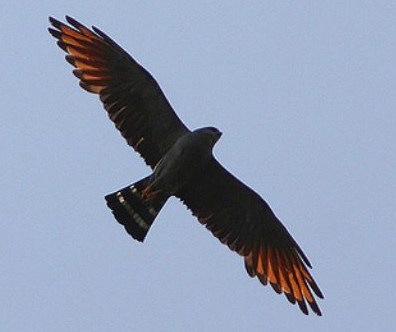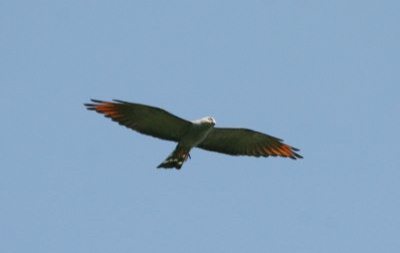Plumbeous Kite and Tiny Hawk

|
The Plumbeous Kite
The Plumbeous Kite, Ictinia plumbea, is a bird of prey in the family Accipitridae, which also includes the eagles, hawks and Old World vultures. The Plumbeous Kite breeds in the tropical New World, from eastern Mexico through Central America to Peru, Bolivia and Argentina. It also breeds on Trinidad. Birds in the north and south of the breeding range, including the populations in Central America, Trinidad, northern Venezuela and Colombia, and southern Argentina and Brazil, are migratory, moving into tropical South America in the northern winter. This is a bird of lowland forest and savannah, which builds a stick nest in a tree and lays one to two blue-white eggs. It is typically thirteen to fifteen inches long and weighs one to 190-280 grams. It is not particularly gregarious, although often seen in flocks on migration. The Plumbeous Kite has long, pointed wings. Adults are mainly slate-grey, with a paler head and underparts. The short black tail has two or three white bands. The eyes are red and the legs are orange. In flight, this kite shows a rufous primary patch. Sexes are similar, but immature birds have white-streaked grey upperparts and dark-streaked whitish underparts. They lack the rufous wing patch. The call of Plumbeous Kite is a whistled si-see-oo. The flight is slow, with frequent glides, and the prey is almost exclusively insects taken in the air. This kite often perches conspicuously on dead branches, with its long wings projecting well beyond the tail. Tiny Hawk
The Tiny Hawk is a small diurnal bird of prey found in or near forests, primarily humid, throughout much of the Neotropics. It is primarily a bird-eater and is known to prey on hummingbirds. The Tiny Hawk is aptly named; males measure a mere eight inches, or about the size of a song thrush, though females are slightly larger at ten and a half inches. The birds range in weight from 75 - 120 grams. As with most raptors, there is considerable sexual dimorphism in size, with females measuring five to twenty six percent longer and as much as sixty percent heavier than males. The adult male Tiny Hawk is dark slaty gray above, with a mottled gray face, a paler gray supercilium, and a blackish crown and nape. The white underparts are covered with fine gray barring, except on the unmarked throat. The longish tail is dark with three paler gray bands. Adult females are similar, but browner above with buffier underparts and browner barring below. Immature birds come in two color morphs: the brown and the rufous. Brown morph birds are dark sooty-brown above, finely barred with black, and white below, heavily barred with cinnamon. Rufous morph immatures are more chestnut above, and barred with rufous (rather than cinnamon) on the underparts. They also have duskier heads and brighter rufous tails than do brown morph birds. The cere and legs of all ages are yellow, and the bill, which is relatively heavy, is gray. Adults have red or red-brown irises, while those of immatures often are yellowish. Unlike most accipiters, the Tiny Hawk's tail is quite short; it is squared or notched at the tip. Its wings are medium-length, with pointed tips, and its legs and toes are long.
ALL IN ALL AN ODD PAIR WE SAW TODAY |


